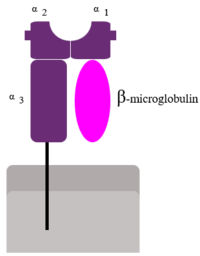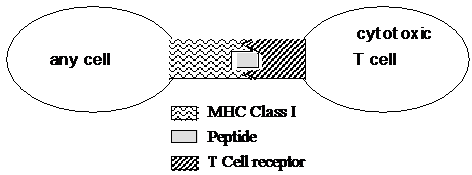User:Jeremiah C Hagler/Sandbox 2
From Proteopedia
(Difference between revisions)
| Line 10: | Line 10: | ||
| - | [[Image:MHC_Class_1.png|200px|left|thumb| Two subunits of MHC I (alpha | + | [[Image:MHC_Class_1.png|200px|left|thumb| Two subunits of MHC I (alpha--contains alpha 1, 2 and 3 domains--and Beta-microglobulin)]][[Image:T-Cell MHC I binding.png]] |
<br> | <br> | ||
<br> | <br> | ||
| Line 19: | Line 19: | ||
<br> | <br> | ||
== Sructure == | == Sructure == | ||
| - | <scene name='71/711668/Wireframe_mhc1/2'>Click | + | <scene name='71/711668/Wireframe_mhc1/2'>Click to open MHC Class I</scene> |
| + | 1. What color is used for the alpha helices? | ||
| + | |||
| + | 2. What color is used for the beta sheet? | ||
| + | |||
| + | 3. Which subunit(s) (in the 3D model) is/are the MHC molecule? Which subunit(s) is/are the peptide? Think of the hot dog and bun analogy... | ||
| + | |||
| + | 4. Which subunit(s) of the MHC molecule play a direct role in binding of the peptide? | ||
| + | |||
| + | * 5. The fit of the peptide in the MHC molecule requires some precision and the peptide must be within a narrow range or lengths. Why do you think this might be (think about the consequences if just any old peptide (of any length) could fit into the MHC groove)? | ||
| + | |||
<br> | <br> | ||
| - | <scene name='71/711668/Mhc_antigen_binding_pocket/1'>MHC Class I binding domain</scene> | + | Hmm...but just how tight does the fit of the peptide look in the MHC groove? Now, open the <scene name='71/711668/Mhc_antigen_binding_pocket/1'>MHC Class I binding domain model</scene>. Here you are seeing only subunits D and F from the previous image. |
| + | |||
| + | 6. What is different - or - where did all the space go? To get a feel for this new view and how it relates to the previous model, click on the "JSmol" at the bottom right corner of the model, deselect “side chain” for subunit 1 and subunit 3. Now this looks a lot more like the previous kinemage image from parts 1-5. | ||
| + | |||
| + | |||
| + | |||
| + | Surprisingly, the fit of the peptide is still not incredibly tight, and many different peptides will fit into any given MHC molecule. | ||
| + | |||
| + | * 7. If you were to alter amino acids in the MHC molecule to (a) affect binding to the peptide, which would you alter? Keep in mind that amino acids within the alpha helices and beta sheets that have side chains that project towards the bound peptide play a crucial role in peptide binding. (b) affect binding to the T cell receptor molecule, which would you alter? (Remember that the T-cell receptor recognizes the whole peptide/binding cleft region as a whole, including amino acids that don’t actually contact the peptide). List 2 amino acids for each answer. (To answer this, click on the image in the area where you would alter something and let the program identify and (symbol of) the amino acid for you.) | ||
| + | |||
| + | |||
| + | |||
| + | |||
| + | |||
| + | |||
| + | |||
| + | The following two questions can be answered without the computer. You may want to skip them for now and keep working. Just make sure that you come back to them later! | ||
| + | |||
| + | * 8. What might be the role of the portion of the MHC not involved in direct binding to the peptide? Use your imagination, look at pictures in your book (Chapter 43), and list as many as you can - don’t worry about the true answer, yet! | ||
| + | |||
| + | |||
| + | |||
| + | |||
| + | |||
| + | |||
| + | |||
| + | |||
| + | |||
| + | |||
| + | * 9. A very similar molecule in your immune system is called MHC Class II. (See diagrams in Campbell, Chapter 43.) This molecule is structurally and functionally analogous to an MHC Class I molecule. Juvenile diabetes is a disease caused (at least in part) when your MHC Class II molecules erroneously present a peptide from your pancreas. This targets the cells of your pancreas for destruction by your immune system and hence the disease -- called an "autoimmune disease" because you are “immune” to yourself. Interestingly, the cause is a mutation in the genes that code for the MHC molecule. From what you have learned so far, it would be reasonable to assume that the mutation has affected the binding of the MHC to the pancreatic peptide. BUT, while this is in part true, the mutation also disrupts a “salt-bridge” (a weak ionic bond) between the two alpha helices. (An example would be a bridge between Asp77 and His151 in the MHC Class I protein). How could this affect peptide binding? Think back to what you know about how a protein shape is determined. | ||
| + | |||
| + | |||
| + | |||
| + | |||
</StructureSection> | </StructureSection> | ||
== References == | == References == | ||
<references/> | <references/> | ||
Revision as of 15:18, 13 September 2015
Protein 1: MHC Class I
| |||||||||||


